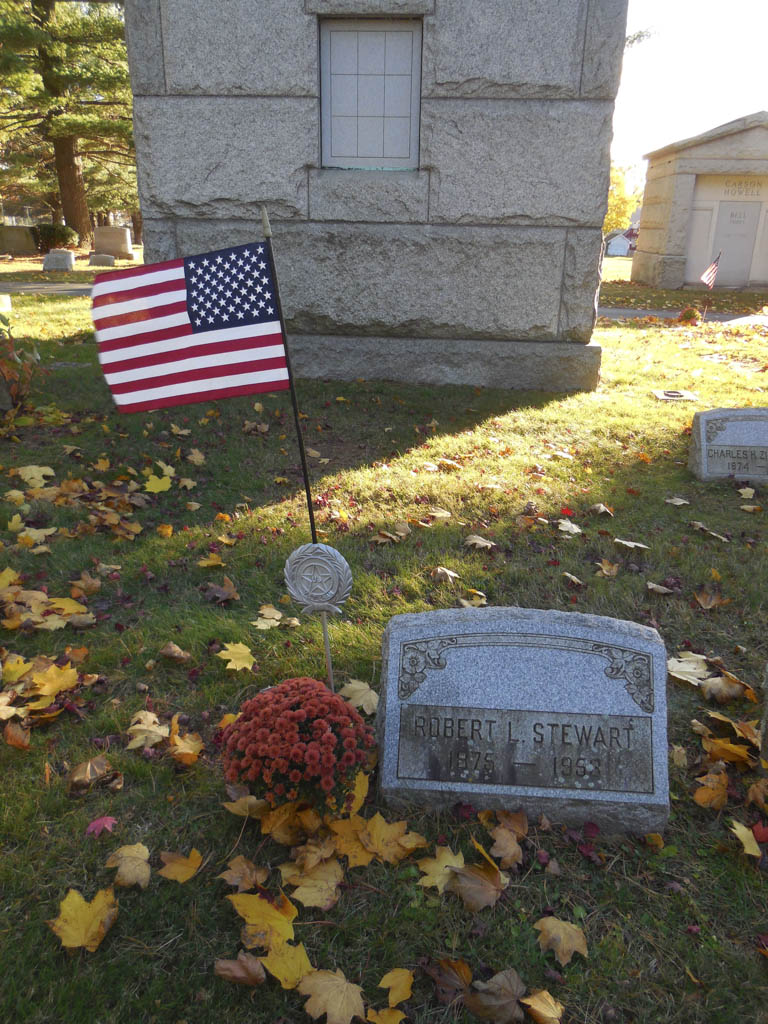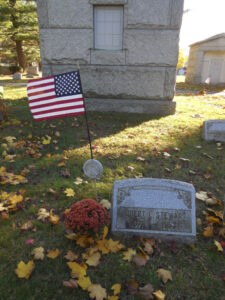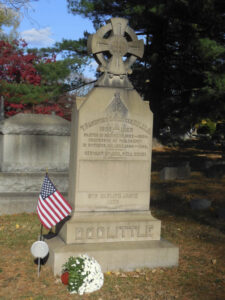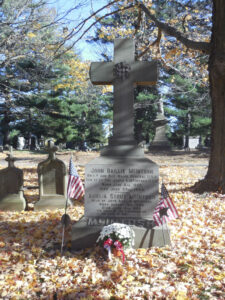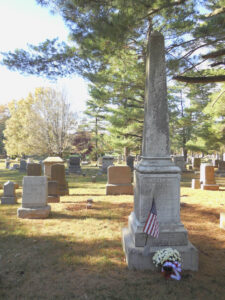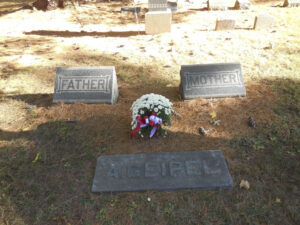By JENNIFER AMATO
Staff Writer
NORTH BRUNSWICK — Elmwood Cemetery in North Brunswick was established in 1868 as part of the Victorian rural cemetery movement a few years after the Civil War ended. The cemetery was created as a garden-like space to be peaceful, serene and full of nature.
“There was a newer understanding of giving your loved ones and family members a place to rest for eternity in peace and serenity,” Rutgers University student Amy Clark said during a historical walking tour of Elmwood on Nov. 11.
As a way to highlight the extensive history of the greater Brunswick area while recognizing the contributions of those who served during the Civil War, Clark, an intern for Elmwood, led a historical walking tour on Veterans Day, visiting the final resting places of nine notables from the war. There are 300 graves of Union soldiers at Elmwood, all of whom have connections to the New Brunswick area.
Clark said the notion of a cemetery and the phrase “rest in peace” comes from the Greek word for sleep.
“The sounds of the city seem to vanish within the gates. It was very intentional on the part of the architect [George Parsell]. It’s very secluded and a place to be reflective and think about and honor those we love,” she said.
She led a group of history buffs along old horse and buggy trails that wind through the cemetery, noting how funeral processions around the time would begin from one mile away.
She first stopped at the grave of Hugh Janeway, who at 18 years old rallied his friends on horseback for a 25-mile trek from New Brunswick to Trenton. Although his group was initially turned down as cavalrymen because the military could not pay for the health of a soldier and a horse, Janeway eventually became a lieutenant with the 1st New Jersey Volunteer Cavalry unit.
Janeway fought 95 battles with “The Fighting Regiment,” and was injured 15 times, even losing his finger. He was killed in battle at age 24, four days before the surrender at the Battle of Appomattox Courthouse, leaving behind his wife and child.
Janeway’s grave marker is faded because the marble used for headstones in the 1800s does not last as long as granite, according to Mark Eyres, superintendent at the Elmwood Cemetery Association, but the cavalry swords are still prominent on the stone.
Janeway’s grandfather had five grandsons who served in the war. Thus, the next stop was Joshua Janeway, who went to college to become a minister and then served as a chaplain for the soldiers, delivering mail, helping the sick and boosting morale for those men who were likely going to die, Clark said. He was a member of the 199th Regiment of the Pennsylvania Civil War Volunteers.
With the expansion of the railroad, traveling from New Jersey to Virginia at the time “was like traveling to a foreign country,” Clark said. She said people were used to dying at home surrounded by loved ones, but during the war, soldiers would die alone or with strangers, usually from debilitating injuries or illness — which made Joshua Janeway’s service important.
Next, Adam Geipel of Austria came to the U.S. in 1858 and joined the 14th New Jersey Volunteer Infantry as a corporal. He was injured in the eye at the Battle of Cold Harbor — which was a Confederate victory — and had to leave the military due to a loss of vision, Clark said.
He returned to New Brunswick as a shoemaker and in what was deemed a “miracle,” he regained sight in his eye. In honor of this miracle, there is an image in a stained glass window of a soldier kneeling before Jesus, who is blessing his eye, at the United Church of Christ at Livingston Avenue and Suydam Street in New Brunswick.
He died at age 89 in 1925.
“Geipel is an example of someone who lived long and prosperous after the war,” Clark said.
Next, Clark took the history seekers to the grave of Dr. Joseph L. Mulford. He was a surgeon for the 48th New York Infantry Regiment, joining at age 31. He had been a doctor in Matawan before being commissioned from September 1861 to September 1864. After the war, he served as an assistant surgeon in Texas and returned to New Brunswick to practice medicine until his death in 1888 at age 57.
At the time, Clark said, doctors would perform surgeries from a manual in unsanitary conditions while prescribing unhealthy cures such as bloodletting and mercury treatments.
She said advances in medicine are owed to the Civil War, especially recordkeeping.
Rear Admiral Charles H. Bell was the fifth veteran mentioned along the tour. He joined the Navy at age 14 as a midshipman, having fought in the War of 1812, the Second Barbary War and the Civil War. He commanded ships tasked with suppressing the slave trade in West Africa, Clark said, one time capturing a transporter with 900 slaves.
He served in the Mediterranean, the Pacific Coast and then on the James River in Virginia, where he helped block ports in the South so that the Confederates could not export cotton and tobacco to Europe, thereby crippling the economy, Clark said.
“The Navy did play an important part in the Civil War, even though a majority of the battles were fought on land,” she said.
A career military man, Bell was memorialized in an obelisk, a tall monument that ancient Egyptians and Greeks thought housed a god.
Next on the tour was John Baillie McIntosh. His older brother James attended West Point while John joined the Navy as a midshipman. John, a major cavalry colonel in the Battle of Gettysburg, fought for the Union while James fought for the Confederates. John was severely injured in the leg during the Shenandoah Valley Campaigns of 1864, which resulted in an amputation; Clark said that rifles were becoming more widespread than bayonets at this time. James was shot in the heart and killed in action 15 minutes into the Battle of Pea Ridge. While John’s remains as a Union soldier lie at Elmwood, James is buried at Fort Smith National Cemetery in Arkansas.
“The story of John and James showed the Civil War was literally a conflict that tore families apart, that pitted brothers against each other,” Clark said.
Although not a veteran, T. Sandford Doolittle was included on the tour because he was a member of the U.S. Christian Commission, a private organization created by the YMCA. He was a pastor in Brooklyn from 1862-64 and a professor of philosophy, a vice president and president at Rutgers College.
Clark said that since soldiers had a lot of downtime, they would play cards, play baseball, build snowmen and even race lice. Doolittle would help them write letters to pass the time.
Some would also engage in the non-Christian practices of gambling and prostitution.
“It was especially important to have people like Doolittle and military chaplains … make sure soldiers made right with God before facing death,” Clark said.
She also said that the U.S. Christian Commission laid the groundwork for Clara Barton and the Red Cross.
The tour proceeded to another member of the Janeway family, Col. Jacob J. Janeway, who was the cousin of Hugh and Josh. Jacob Janeway was a brevet colonel with the 14th New Jersey Volunteer Infantry, meaning he was promoted while on the battlefield. Since Elmwood has 30 members of the 14th Regiment buried on site, it is likely Jacob Janeway oversaw Adam Geipel, Clark said.
After the war, Jacob Janeway partnered with Charles Carpenter in New Brunswick in a successful wallpaper business that went from Nielsen Street in New Brunswick — and then Church Street and Paterson Street before being lost to a fire — to as far west as Chicago.
Carpenter is well known in New Brunswick, with Carpenter Hall on the Douglass campus of Rutgers University bearing his name.
“This is a good example of surviving the war and making an honest living,” Clark said, alluding to the next veteran, John Hill, living a very different life.
Hill came from a prominent family, Clark said. He was a major with the 12th New Jersey Volunteer Infantry, known as the “Buck and Ball” Regiment. These soldiers were responsible for securing Bliss Farm during the Battle of Gettysburg from the Confederates. Hill led the Buck and Ball, retaking the farm so that the Union would win Gettysburg. The site bears a memorial for the 12th Infantry soldiers, Clark said.
However, though he worked as a banker in New York after the war, Clark said it was discovered after his death that Hill had embezzled $400,000 from the bank — the equivalent of $10 million today.
Since the majority of the war was fought on southern soil, and since the Navy had blocked exportation from ports, the South was devastated economically, geographically and morally, Clark said. Slaves had escaped so there were less laborers on southern plantations.
President Abraham Lincoln was assassinated just five days after the surrender at the Appomattox Courthouse by the Confederation in 1865 while attending a play at Ford’s Theater in Washington, D.C., by Confederate supporter John Wilkes Booth.
However, on the upside, the 13th Amendment to the U.S. Constitution abolished slavery, the 14th Amendment provided an equal protection of the laws and the 15th Amendment enfranchised black male voters.
Nonetheless, the South saw an increase of rising against blacks and Jim Crow laws, which enforced segregation.
Clark said the Civil War has been called “unfinished” because though progress has been made, similar issues still exist in American society today.
“It’s something that speaks to the great promise of this country, that makes veterans and the great people of this country want to fight for,” she said.
Elmwood Cemetery is a Victorian garden cemetery founded in 1868. The founders designed a cemetery where a beautiful landscaped park would create a respite from expanding cities, according to Eleanor Molloy of the Elmwood Cemetery Association. Because of their vision, Elmwood is a preserve of 50 acres of native trees and shrubs, a home to many birds and wildlife.
The cemetery’s garden has been certified as a Monarch Waystation and a North American butterfly garden and was created to provide milkweeds and nectar sources for butterflies native to New Jersey, particularly the monarch butterfly, Molloy said.
In addition, Elmwood opened its grounds to the public for a luminaria on Nov. 6, lighting more than 3,000 candles on site.
For more information on special events at Elmwood, visit www.TheElmwoodCemetery.com/events, call 732-545-1445 or email [email protected].
Contact Jennifer Amato at [email protected].

